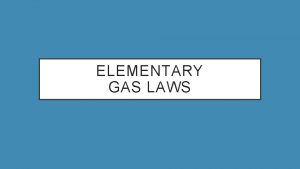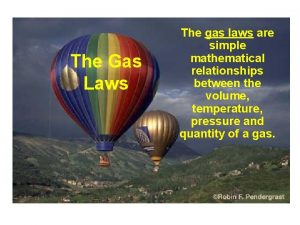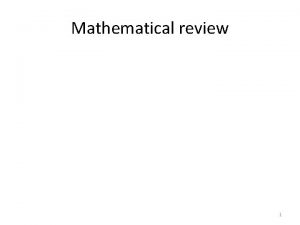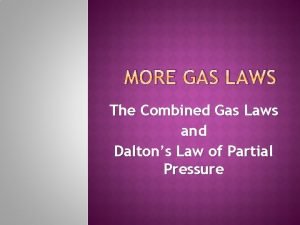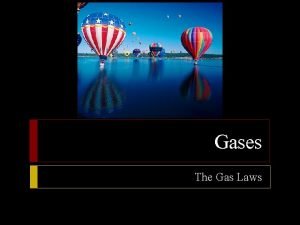Gas Laws The gas laws are simple mathematical



















- Slides: 19

Gas Laws

• The gas laws are simple mathematical relationships between pressure, volume, temperature, and the amount of a gas. • They were developed by scientists who experimented with a variety of gases and were able to observe the relationships among these variables.

Boyle’s Law • What happens to the volume of a gas when you increase the pressure? • What happens to the pressure when you increase the volume? • Boyle’s Law relates the volume and pressure of a gas. It assumes that the temperature and the number of gas particles remain constant/


• A balloon filled with helium gas has a volume of 500. m. L at a pressure of 1. 00 atm. The balloon is released into the air. When the balloon is high enough that the pressure is 0. 750 atm, what is the volume of the gas?

• The volume of a sample of gas is 425 m. L at a pressure of 1. 05 atm. What would be the pressure of the gas, in k. Pa, if the volume is decreased to 215 m. L while the temperature is held constant?

Charles’ Law • If the temperature of a gas increases, but the pressure stays the same, what will happen to the volume of the gas? • Charles’ Law is the mathematical relationship between temperature and volume. • It assumes that the pressure and the number of gas particles remain constant.


• To solve the problem of negative temperatures, the Kelvin temperature scale is used for all gas laws. • The lowest temperature in the Kelvin scale is 0 K, also known as absolute zero. Note that no degree symbol is used with the Kelvin scale. • To convert from o. C to K, simply add 273. – This means that the magnitude of a celsius degree and a Kelvin is exactly the same, the Kelvin scale has just been moved downward by 273 degrees. – Therefore, absolute zero is 0 K or -273 o. C

• A sample of neon gas has a volume of 752 m. L at 25. 0 o. C. What will the volume be at 100. o. C if the pressure is constant?

• A sample of nitrogen gas has a volume of 375 m. L at a temperature of 0. 0 o. C. If the gas is heated and the volume increases to 500. m. L, what is the new temperature of the gas (in Celsius degrees)?

Gay-Lussac’s Law • Gay-Lussac’s Law relates the pressure and temperature of a gas while the volume is held constant. • If the temperature of a gas decreases, what will happen to the pressure?


• At 125 o. C, the pressure of a sample of oxygen is 764 mm Hg. What will be the pressure of the sample if the temperature is increased to 175 o. C?

• A sample of helium gas has a pressure of 115 k. Pa when the temperature is 22 o. C. What will be the temperature, in Celsius, if the pressure is reduced to 103 k. Pa?

Combined Gas Law • In the first 3 gas laws, one variable has been held constant. • Often when a gas sample undergoes changes, pressure, temperature, and volume ALL change. • Boyle’s, Charles’ and Gay-Lussac’s laws can be combined into a single law called the combined gas law.


• The volume of a gas is 32. 5 m. L at 22 o. C and 0. 985 atm. What will be the volume of the gas at STP?

• A sample of fluorine gas occupies 1. 5 L at 26. 5 o. C and 1. 00 atm. What will be the pressure of the gas if the volume increases to 2. 5 L and the temperature increases to 40. 0 o. C?
 Antigentest åre
Antigentest åre What is mathematical economics
What is mathematical economics Mathematical logic laws
Mathematical logic laws Useless laws weaken the necessary laws
Useless laws weaken the necessary laws Interest in mathematical literacy
Interest in mathematical literacy Hình ảnh bộ gõ cơ thể búng tay
Hình ảnh bộ gõ cơ thể búng tay Ng-html
Ng-html Bổ thể
Bổ thể Tỉ lệ cơ thể trẻ em
Tỉ lệ cơ thể trẻ em Gấu đi như thế nào
Gấu đi như thế nào Thang điểm glasgow
Thang điểm glasgow Alleluia hat len nguoi oi
Alleluia hat len nguoi oi Môn thể thao bắt đầu bằng từ chạy
Môn thể thao bắt đầu bằng từ chạy Thế nào là hệ số cao nhất
Thế nào là hệ số cao nhất Các châu lục và đại dương trên thế giới
Các châu lục và đại dương trên thế giới Công thức tiính động năng
Công thức tiính động năng Trời xanh đây là của chúng ta thể thơ
Trời xanh đây là của chúng ta thể thơ Mật thư tọa độ 5x5
Mật thư tọa độ 5x5 Phép trừ bù
Phép trừ bù độ dài liên kết
độ dài liên kết




















